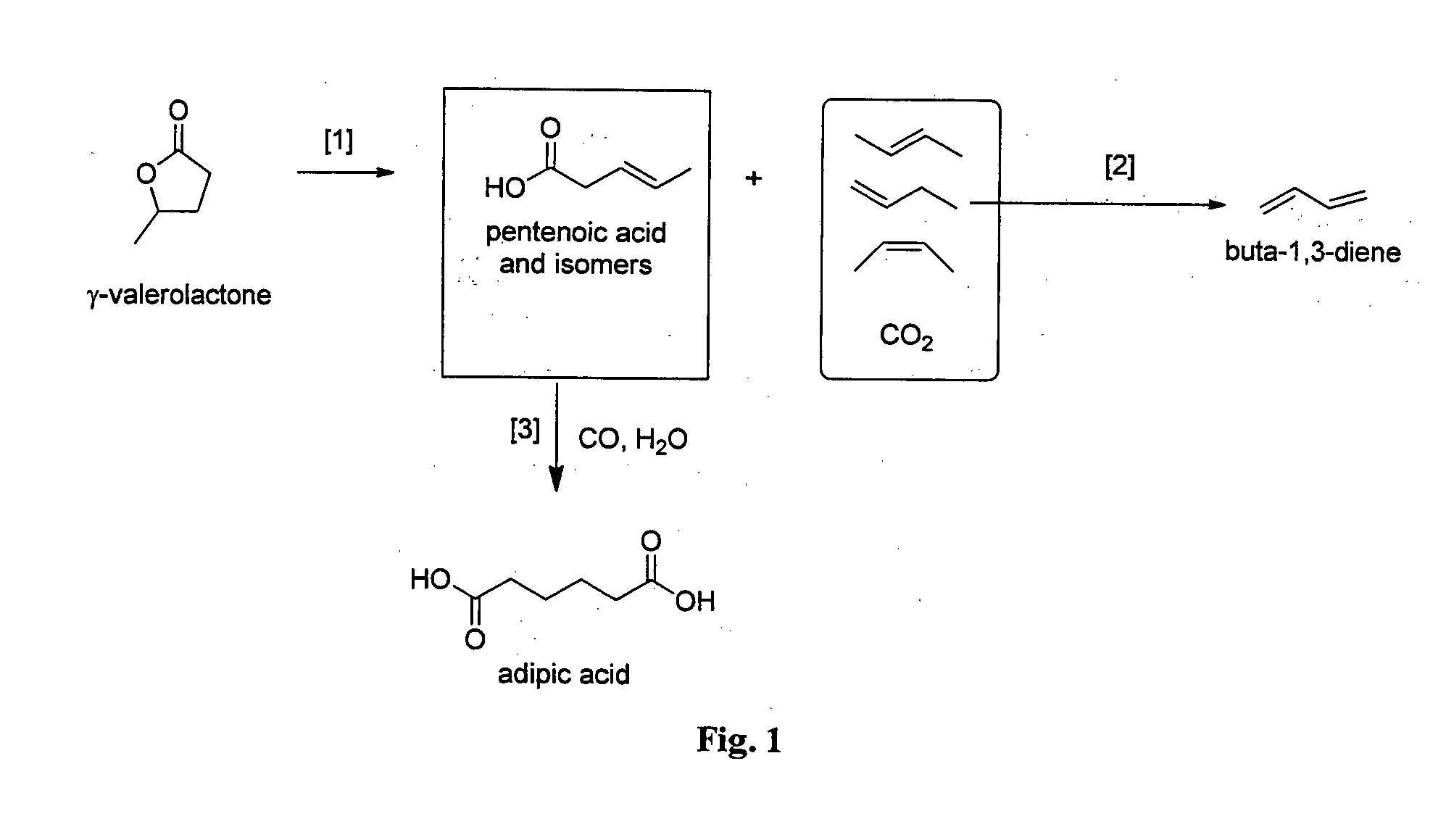Process to produce a diene from a lactone
a technology of lactone and diene, which is applied in the preparation of carboxylic compounds, hydrocarbon preparation catalysts, organic chemistry, etc., can solve the problems of excessive energy and chemical utilization efficiency of nylon monomers, and achieve the effect of reducing intermediate purification steps and less waste streams
- Summary
- Abstract
- Description
- Claims
- Application Information
AI Technical Summary
Benefits of technology
Problems solved by technology
Method used
Image
Examples
example 1
Preparation of Pentenoic Acid Isomers and Butenes Via Catalytic Reaction of γ-Valerolactone
[0210]The conversion of GVL to PEA was carried out in an up-flow fixed bed reactor (ID=6 mm) loaded with catalyst silica-alumina (Sigma Aldrich, grade 135.6 g). The reactor was seated in a tubular furnace with temperature controller. GVL (Sigma Aldrich) was fed using a HPLC pump (Lab Alliance Series I) to get the required weight-hourly space velocities (WHSV). The system pressure was controlled by a back pressure regulator at 32 bar. The reaction product was analysed by GC. The experimental results are summarized in Table 1.
TABLE 1Reaction conversion and selectivityTemper-GVLProduct selectivityatureWHSVconver-%Experiment(° C.)h−1sion %PEAbuteneothers12801.014.286.612.41.023000.532.448.850.30.933301.067.214.184.81.1
example 2
Carbonylation of Isomeric Mixtures of Pentenoic Acids to Adipic Acid
[0211]The stainless steel 300 ml Parr reactor was charged with degassed diglyme (40 ml), degassed deionised water (5.0 ml, 278 mmol), and degassed concentrated PEA mixtures (13.6 ml, 64.3 mmol PEA isomers, distillate composition by GC: 2-PEA, 12%; 3-PEA, 20%; 4-PEA, 14%; GVL, 54%) under a stream of argon gas. The Parr reactor was evacuated and refilled with CO (2 bar). A yellow solution of catalyst consisted of palladium acetate (30.5 mg, 0.14 mmol), 1,2-bis[di(t-butyl)phosphinomethyl]benzene (108.2 mg, 0.27 mmol), and methane sulfonic acid (0.1 mL, 1.5 mmol) in diglyme (10 ml) was injected into the reactor under a stream of CO gas. After that the Parr reactor was pressurized with CO (60 bar). The reaction mixture was stirred at 1000 rpm. The Parr reactor was heated at 105° C. for 5 h. After 5 h, the reactor was cooled, vented and opened to air. A yellow reaction mixture was obtained which was placed in the fridge t...
PUM
| Property | Measurement | Unit |
|---|---|---|
| Temperature | aaaaa | aaaaa |
| Temperature | aaaaa | aaaaa |
| Pressure | aaaaa | aaaaa |
Abstract
Description
Claims
Application Information
 Login to View More
Login to View More - R&D
- Intellectual Property
- Life Sciences
- Materials
- Tech Scout
- Unparalleled Data Quality
- Higher Quality Content
- 60% Fewer Hallucinations
Browse by: Latest US Patents, China's latest patents, Technical Efficacy Thesaurus, Application Domain, Technology Topic, Popular Technical Reports.
© 2025 PatSnap. All rights reserved.Legal|Privacy policy|Modern Slavery Act Transparency Statement|Sitemap|About US| Contact US: help@patsnap.com



